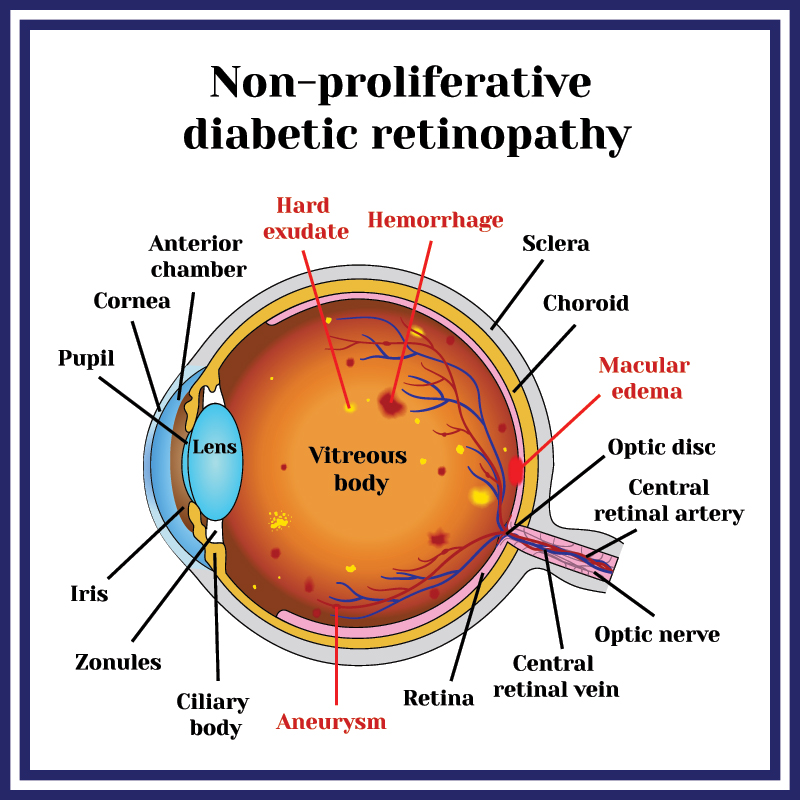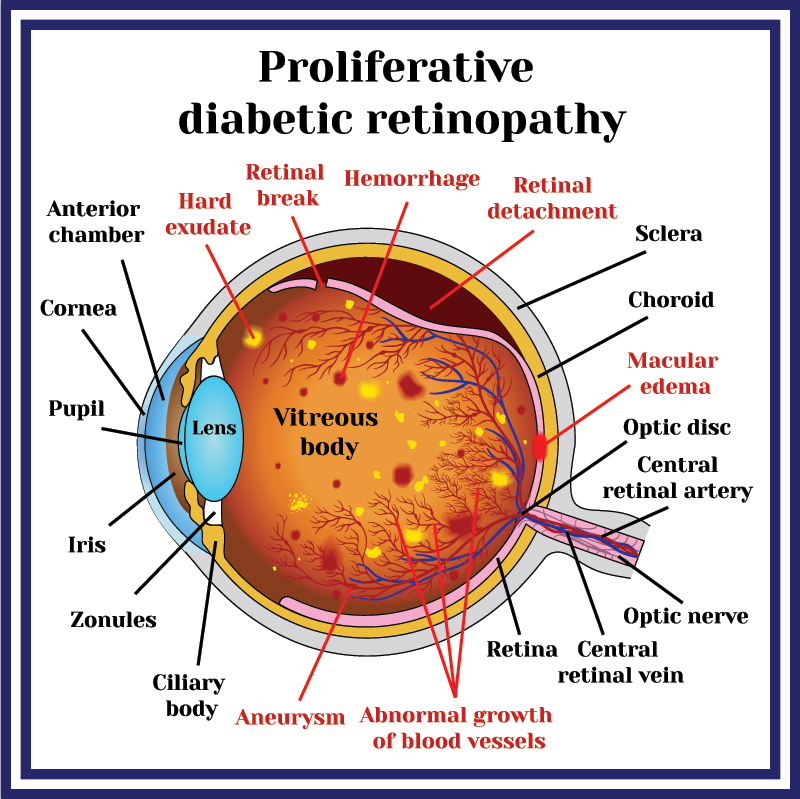How Diabetic Retinopathy Works
People with diabetes can get an ocular complication called diabetic retinopathy which causes damage to their retinal blood vessels due to elevated sugar levels. During the initial stages of this condition, you may be asymptomatic. In more advanced stages, you may notice symptoms such as blurred vision, floaters, distortion, fading of colors and/or a shadow across the field of your vision. Dr George Khouri is fellowship trained in retinal diseases which makes him very well versed in the diagnosis and treatment of this condition.
In the early stages, retinal blood vessels leak fluid in the retinal tissues resulting in swelling of these tissues especially in the macula, the central part of the retina. This condition is called macular edema and is the most common cause of decreased vision in diabetic retinopathy. This is one of the signs of the first stage which is called non proliferative diabetic retinopathy. At this stage, some blood vessels can also close off, a condition called macular ischemia which prevents the macula from being nourished with oxygen and nutrients. This can result in the appearance of cotton wool spots which are small yellow-white spots. In certain cases there is accumulation of small areas of swelling called exudates which can affect your vision. The walls of retinal vessels usually become weak and start forming a localized enlargement called aneurysm which has the tendency to leak blood resulting in retinal hemorrhages.

As the condition progresses, the retina starts growth and proliferation of abnormal new blood vessels also known as neovascularization. These new blood vessels grow outside the surface of the retina into the vitreous cavity, the jelly like substance in your eye located between the lens and the retina. This advanced stage of the disease is called proliferative diabetic retinopathy. The wall lining of these vessels is defective, making them fragile and likely to bleed into the vitreous, known as vitreous hemorrhage. This can manifest as floaters and can even block the field of vision almost completely. Scar tissue also forms due to these abnormal new vessels. Pulling and traction on the retina by this scar tissue can occur, leading to retinal tears and tractional retinal detachment with decreased vision.

Diagnostic Testing For Diabetic Retinopathy
The first step in the diagnosis is to dilate both eyes in order to visualize the retina and vitreous. This is why regular dilated eye examinations by an ophthalmologist are essential.
Optical coherence tomography (OCT) provides high resolution cross sectional images of the retina to determine if there is fluid in the macula by showing its thickness. Fundus Photography also helps visualize the retina. OCT and fundus photography provide a way to monitor the condition on follow up visits and check its progress. Fluorescein angiography is a test which evaluates the retinal circulation and is conducted by injecting fluorescein dye in your arm and taking sequential black and white photographs to study its course and determine which vessels are leaking, damaged or closed off. This dye is like a food colorant and does not affect the kidneys as compared to dyes used for CAT scans and MRI scans. In the event the vitreous hemorrhage is significant to the extent that it blocks the view of the clinician, B-scan ultrasonography can determine if the retina is attached or detached and helps to follow progression to determine the timing and approach of treatment.
Diabetic Retinopathy Treatment Options
Intravitreal injections are used to treat macular edema. The injections consist of medications given in the vitreous cavity. These medications inhibit vascular endothelial growth factor (VEGF), a chemical which stimulates retinal leakage and abnormal blood vessel growth (neovasularization). They are usually given in the office to help treat or reverse the signs and symptoms of retinopathy. These injections may need to be repeated for effective treatment. Examples of anti VEGF injections include Avastin, Lucentis and Eylea. Sometimes, a steroid injection is used to complement anti VEGF injections. Focal laser surgery is used in some cases to seal off leaking blood vessels. Retinal neovascularization can also be treated with panretinal photocoagulation (PRP) laser surgery to help regression of the abnormal blood vessels. The way PRP works is to destroy the oxygen deprived retinal tissue outside of the patient’s central vision that leads to production of VEGF and subsequent retinal damage. In certain instances where there is vitreous hemorrhage from proliferative diabetic retinopathy which does not respond to these modalities, surgical removal of the blood in the vitreous and scar tissue from the surface of the retina can be removed with a procedure known as vitrectomy. This procedure is used to treat, reverse or prevent the development of scar tissue that can lead to tractional retinal tears and detachment.
Preventing Diabetic Retinopathy
If you have diabetes, the best way to prevent or treat visual loss that may occur is to take your medications regularly, keep a healthy weight with a good diet and become more physically active, It is also important to control high blood pressure and cholesterol as well as avoid smoking. Regular dilated eye examinations by an ophthalmologist will also minimize the risk of complications. The frequency of these examinations will depend on the severity of the retinopathy if present. If no retinopathy is present, yearly examinations are recommended.
FAQs
What is diabetic retinopathy?
 Diabetic retinopathy is an eye condition affecting people with diabetes, caused by damage to the tiny blood vessels in the retina due to high blood sugar. It can lead to vision loss if not treated in time.
Diabetic retinopathy is an eye condition affecting people with diabetes, caused by damage to the tiny blood vessels in the retina due to high blood sugar. It can lead to vision loss if not treated in time.
Who is at risk for diabetic retinopathy?
Anyone with diabetes — type 1 or type 2 — is at risk. The longer you have diabetes, the higher the risk, especially if blood sugar is not well-controlled. High blood pressure, high cholesterol, smoking, and pregnancy with diabetes are also risk factors.
How often should someone with diabetes get an eye exam?
It is recommended that individuals with diabetes undergo a comprehensive dilated eye exam at least once a year. Depending on your condition, your doctor may suggest more frequent exams. Pregnant women with diabetes should have their eyes checked during the first trimester and more frequently if advised by a doctor.
What are the symptoms of diabetic retinopathy?
Diabetic retinopathy often doesn’t show symptoms in its early stages. However, as it progresses, you may experience blurred vision, floaters, difficulty seeing at night, or even sudden vision loss. Regular eye exams are essential for catching it early.
How does controlling blood sugar help with diabetic retinopathy?
Maintaining good blood sugar control is one of the most effective ways to prevent or slow the progression of diabetic retinopathy. High blood sugar can cause the retinal blood vessels to leak or grow abnormally, leading to vision problems. By keeping your blood sugar levels within a healthy range, you reduce the risk of further damage to your eyes.
How does diet affect diabetic retinopathy?
A healthy diet is crucial for managing diabetes and, in turn, protecting your vision. Eating a balanced diet with a focus on whole grains, lean proteins, vegetables, and low glycemic index foods can help control blood sugar levels. Omega-3 fatty acids, antioxidants, and other nutrients can also support eye health and slow the progression of diabetic retinopathy.
How is diabetic retinopathy diagnosed?
A dilated eye exam is the primary method for diagnosing diabetic retinopathy. During this exam, your eye doctor will look for signs of damaged blood vessels in your retina. Additional imaging tests may be performed to evaluate the extent of the damage.
How effective is laser surgery for diabetic retinopathy?
Laser surgery, or photocoagulation, is a common and effective treatment for diabetic retinopathy. The procedure uses a laser to seal off leaking blood vessels or shrink abnormal ones, preventing further vision loss. While it doesn’t cure the condition, it is highly effective in slowing its progression, especially in the early stages.
What are the treatment options for diabetic retinopathy?
Treatment depends on the severity of the condition. Early-stage diabetic retinopathy often requires no immediate treatment beyond managing blood sugar levels. Advanced cases may be treated with laser therapy, anti-VEGF injections to prevent abnormal blood vessel growth, or vitrectomy surgery to remove blood or scar tissue inside the eye.
What are the long-term management strategies for diabetic retinopathy?
Long-term management focuses on maintaining stable blood sugar, blood pressure, and cholesterol levels to prevent further damage. Regular eye exams, monitoring for changes in vision, and following your doctor’s treatment plan — whether it includes medication, surgery, or lifestyle changes — are key. A healthy diet, exercise, and avoiding smoking are also critical for long-term management.
To find out how these treatments may help you, contact us today to schedule your appointment with Dr. Khouri.









